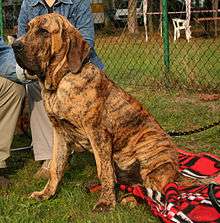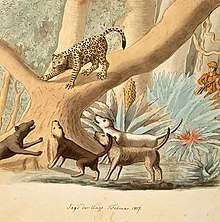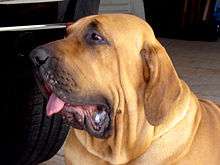Fila Brasileiro
The Fila Brasileiro (Portuguese pronunciation: [ˈfilɐ ˌbraziˈlejɾu]), or Brazilian Mastiff, is a large working breed of dog developed in Brazil.[1] It is known for its superb tracking ability, aggressiveness and an unforgiving, impetuous temperament. Rather than attacking its prey, the Fila traps it and waits for the hunter to arrive. Owing to these qualities, the Fila Brasileiro is used as a guard dog, as a cattle dog for livestock and as a hunting dog for tracking and controlling large game. When slavery was legal in Brazil in the 18th century, the Fila Brasileiro was used to return fugitive slaves unharmed to their masters.[2]
| Fila Brasileiro | |||||||||||||||||||||||||||||
|---|---|---|---|---|---|---|---|---|---|---|---|---|---|---|---|---|---|---|---|---|---|---|---|---|---|---|---|---|---|
 | |||||||||||||||||||||||||||||
| Other names |
| ||||||||||||||||||||||||||||
| Origin | Brazil | ||||||||||||||||||||||||||||
| |||||||||||||||||||||||||||||
| |||||||||||||||||||||||||||||
| Dog (domestic dog) | |||||||||||||||||||||||||||||
Etymology
The verb "Filar" in Portuguese literally means "hold, arrest, grab".[3] So "Cão de Fila" (Fila dog) or "Cão de filar" suggests that it is a "catch dog", a dog that "bites and does not loosen its grip". A similar name is also found in two Portuguese dog breeds: the Cão de Fila de São Miguel and the extinct Cão de Fila da Terceira.
History

One theory is that the breed is a combination between the English Mastiff, Bloodhound and old Bulldog of the 15th century.[4] Another theory is that the Fila is the result of the crossbreeding between Portuguese and Spanish dogs brought to Brazil during the Iberian Union period.[5] In this case, the Fila would have as possible ascendents the Spanish Mastiff, Cão de Castro Laboreiro, Cão de Gado Transmontano, Rafeiro do Alentejo, Cão Fila de São Miguel, etc., or the predecessor of these breeds (the Iberian Alaunt), possibly combined with scent hounds.
The Fila Brasileiro were bred and raised primarily on large plantations and cattle farms where they originated. In addition to cattle, jaguars, and other animals, these dogs were taught to chase down runaway slaves.[2] The dogs would grab the slave or animals by the neck and hold them until the farmer arrived. This instinct can be observed among puppies when they are playing.
The first written standard of the breed was edited in 1946. The Paulistas were responsible for organizing a planned breeding program and opening a stud book to register dogs. Dr. Paulo Santos Cruz began to systematically breed the Fila Brasileiro and also contributed largely in setting the CAFIB standard, and who now, therefore, has the right to be called the "father" of the Fila Brasileiro.[6]
About the registries, CBKC (Brazilian Confederation Kennel Club) follows the FCI (Federation Cynologique Internationale) policy and accepts for registration only dogs with FCI pedigrees, orienting the breeders to have hip dysplasia control, besides other health problems. The Fila Brasileiro is described as a Brazilian Mastiff or a Brazilian Molosser. In the U.S., the OFA (Orthopedic Foundation for Animals) does a statistical registry of all Filas that were X-rayed to diagnose hip dysplasia.
The Brazilian army compared this breed to Doberman Pinschers and German Shepherds in a five-year study using these dogs in the jungle under extremely hostile conditions. The following traits were observed: intelligence, aggressiveness, sensibility, temperament, energy, resistance, rusticity and strength. German Shepherds were found to have the highest intelligence and Doberman Pinschers the highest level of aggression. The Fila Brasileiro was found to be superior in every other category.
Appearance
In Brazil the breed has two main standards imposed by two distinct clubs, the CBKC (Brazilian Confederation of Cynophilia) affiliated to FCI, and the CAFIB (Fila Brasileiro's Enhancement Club).[7][6][1] Consequently, the stock of each club has visible morphological differences.[8] The CAFIB standard was constructed based on the ancient phenotype of the breed.[6] But the current CBKC/FCI standard is the best known internationally.[1]
The Fila Brasileiro is a molosser breed with large bones and loose skin. The FCI breed standard requires males to be between 65 and 75 cm (25.5 inches to 29.5 inches) high at the withers and weigh 50 to 82 kilograms (110 to 181 lb).[1] Females are slightly smaller and are expected to be 60 to 70 cm (23.5 inches to 27.5 inches) high at the withers and weigh at least 41 kg (90 lbs).[1] They have a rectangular build and though they are massive, their natural agility is apparent. The head is big and heavy with a deep muzzle. The ears are large, thick, tapered and either droop or fold back exposing the interior, depending on the dog's mood. The neck and back are well muscled and the chest is broad and deep. Unlike the vast majority of canines, the croup is higher than the withers. The legs are heavily boned. The skin is very distinctive of the breed, as it is thick and loose all over the body, mainly in the region around the neck. The thick skin forms pronounced dewlaps. In many individuals, the dewlaps proceed to the chest and abdomen. Some dogs show a fold at the side of the head and also at the withers descending to the shoulders. The coat is short and dense and the texture is normally smooth and soft. Their colours vary from solid, brindle, mouse-grey, patched, dappled, or black and tan. They are almost never white. Typical colours are fawn, black and brindle. Brindles of a basic color may have the stripes of either less or with very strong intensity. Sometimes a black mask is present.[1]
Though large in size, the Fila does not appear static. Rather it is harmonious, cat-like and, above all, powerful. The Fila appears self-assured and calm but is never absent in expression. When at attention, the gaze of the Fila Brasileiro is firm, alert and unwavering. Another typical characteristic of the breed is its gait, which is similar to that of a camel, moving two legs of one side at a time. The gait gives it a typical rolling lateral movement on the throat and the hindquarters which is accentuated when the dog's tail is raised. The head is typically lower than the backline. The characteristic carriage and gait has earned it great success in dog shows.
The coat of the Fila Brasileiro is smooth and short. Black, fawns (red, apricot, or dark), and brindled (fawn, black, or brown brindle) colors are permitted, except mouse-grey, black and tan, blue, dappled and solid white. White markings, not exceeding 1/4 of the coat surface area, are permitted on the feet, the chest and the tip of the tail in the FCI standard.
The CAFIB standard does not accept black, mouse-grey, black and tan, blue, or dappled coats, as it considers them as a sign of crossbreeding; on the other hand, it accepts dogs with large white markings on any part of the body.[9]
Standards
In Brazil the Fila Brasileiro can be bred within three different standards proposed by three separate clubs.[7][1][10] The standard imposed by the CBKC (a club affiliated to the FCI) is the most popular in the world, but it is by far the most distant from the appearance of the old dogs of four decades ago.[1]
The other two standards are from CAFIB (Fila Brasileiro's Enhancement Club) and AMFIBRA (World Association of Dog Breeders of Fila Brasileiro), respectively.[7][11] Both are based on the first breed standard elaborated by Paulo Santos Cruz, the man who is considered the "father of the breed".[10] However, the CAFIB standard is the most popular of the two. But both clubs (CAFIB and AMFIBRA) present themselves with the aim to preserve the pure Fila with the closest appearance of the old dogs.[7][6][11]
This big difference between the three standards is mainly due to an accusation of a scandal of crossbreeding at the dogs registered by the CBKC in the 70's, 80's and 90's and, consequently, the many changes made in the CBKC standard probable to include dogs with characteristics of foreign breeds, such as the English Mastiff, Great Dane and Neapolitan Mastiff.[6][1][7]
Paulo Santos Cruz himself, who even participated in the formation of the CAFIB for these same reasons and even presided over the club, published an article in 1979 explaining how to differentiate a pure Fila from a mixed one.[12][6]
Temperament

Fila Brasileiros are known to be naturally protective. They are bred to be aggressive. It is also known for its extreme wariness of strangers and agility when protecting or defending its master. The dedication and obedience of the Fila Brasileiro has found its way into the Brazilian saying "as faithful as a Fila".[13]
The Fila Brasileiro temperament is what characterizes the dog. The Portuguese word for their temperament is "ojeriza", which directly translated into English means "dislike" or "distrust". The socialization period (about the first year with the first six to eight months being the most important) of the dog's life is crucial to the temperament of the individual dog. If the pup is exposed to a lot of people in a positive manner (known as 'socializing'), the pup (keeping in mind the dog's natural protective instincts) can be encouraged to behave in a calm manner in public, but emphasis should be placed on the fact that socialization is done differently from other breeds. Despite extensive socialization, the Fila is instinctively protective and will naturally guard and protect its owner, their family members and the family pets; this is not something that needs to be trained, it is an innate trait. Strangers should not be left unattended with a Fila and, like all other guardian breeds, it may not be the best choice for those who have frequent visitors to their homes. Lack of all socialization with strangers at a young age will result in a dog which is very anti-social.
Common ailments
Fila Brasileiros are prone to large breed ailments, including hip dysplasia, gastric torsion and elbow dysplasia. These dogs require plenty of exercise and hence are not very well suited to city life. Open country with fenced yards are very good for the dogs, as it gives them plenty of room to run and exercise.
Life expectancy
Filas are known to live up to about nine to 11 years.
Legal status
In Fiji,[14] the United Kingdom,[15] Norway,[16] Malta[17] and Cyprus[18] it is illegal to own any of these dogs without specific exemption from a court. In Australia, in the states of Queensland, New South Wales, Victoria, South Australia and Western Australia the Fila is a restricted or proscribed breed. Imports are also prohibited. They are automatically classified as a dangerous dog in New Zealand and Trinidad & Tobago,[19] meaning they cannot be imported and males must be neutered.
See also
- Original Fila Brasileiro
- Dogue Brasileiro
- Terrier Brasileiro
- Campeiro Bulldog
- Fila da Terceira
- Gaucho Sheepdog
- Bullbras
- Cão de Fila de São Miguel
References
- "CBKC/FCI Breed standard" (PDF). Retrieved 22 March 2018.
- "Europetnet - Fila Brasileiro". www.europetnet.com. Retrieved 2 February 2019.
- "Filar". Dicio.com.br (in Portuguese). Retrieved 21 September 2018.
- "Fila Brasileiro - Guia de Raça de Cachorro - Dog Times". Dogtimes.com.br (in Portuguese). Retrieved 20 September 2018.
- "Fila Brasileiro". Fofuxo.xom.br (in Portuguese). Retrieved 20 September 2018.
- "CAFIB - Summary about the history of the Brazilian Fila (Portuguese)". Cafibbrasil.com. Retrieved 22 March 2018.
- "CAFIB standard (Portuguese)". Cafibbrasil.com. Retrieved 22 March 2018.
- "CAFIB - Gallery: 2ª Exposição de Jacareí". Cafibbrasil.com. Retrieved 22 March 2018.
- "CAFIB standard (in Portuguese)". Cafibbrasil.com. Retrieved 22 March 2018.
- "AMFIBRA Breed standard" (in Portuguese). Retrieved 3 October 2018.
- "AMFIBRA" (in Portuguese). Retrieved 3 October 2018.
- "Paulo Santos Cruz Article". Fila Goiano Kennel (in Portuguese). Retrieved 3 October 2018.
- "Fila Brasileiro Community Portal". Fila-brasileiro.org. Retrieved 1 April 2013.
- "Fiji Pet Passport Regulations". Pettravel.com. Pet Travel, Inc. Retrieved 27 March 2017.
- "Moving a Pet to the UK". Starwood Animal Transport.
- "Forskrift om hunder". Lovdata. 25 August 2009. Retrieved 25 August 2009.
- "Importation of Pets in Malta". MFGC. 2 March 2010. Archived from the original on 5 November 2009. Retrieved 2 March 2010.
- "Essential Animal Contacts". Cyprus.angloinfo.com. 4 February 2011. Retrieved 4 February 2011.
- "THE DANGEROUS DOGS ACT, 2000" (PDF). Ttparliament.org. Retrieved 21 September 2018.
External links
| Wikimedia Commons has media related to Brazilian Fila. |